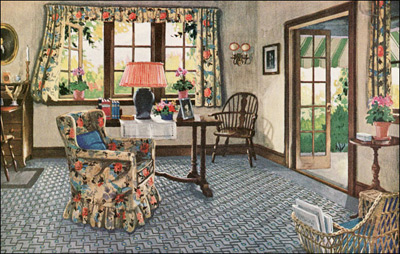During the 20th century, two design philosophies, traditional and modern, vied for supremacy. Although the traditional style has flourished in terms of popularity, it hasn't achieved a definitive victory. Let's delve into the captivating world of Colonial and Traditional interior design, where history blends harmoniously with comfort.
A Journey Through Time
Colonial, the most notable traditional style from 1900 to 1960, encompasses two substyles: Early American and 18th Century Colonial. These styles captured the essence of American homes, combining formal and casual elements in innovative ways. Take a look at this image of a 1926 Colonial sitting room, a splendid representation of this unique design approach.
 1926 Colonial Sitting Room - Blabon Linoleum
1926 Colonial Sitting Room - Blabon Linoleum
The Allure of 18th Century Colonial
From the turn of the 20th century onward, the 18th Century Colonial interior style has gained immense popularity. This formal style boasts high-quality furnishings and materials, including tapestries, brocades, velveteens, and linen. The influence of English styles is palpable, giving these spaces an elegant and refined ambiance. Homeowners sought out fine old antiques from the 18th and early 19th centuries, such as mahogany secretaries, antique wing chairs, and pie crust or game tables. Decorative accessories like Staffordshire ceramics, candlestick lamps, and gold-leaf mirrors added the perfect finishing touch.
Larger Colonial Revival and Neo-classical homes, with their spacious rooms and high ceilings, provided the ideal canvas for showcasing such exquisite furnishings and decor.
The Charm of Early American
In contrast to the formal 18th Century Colonial style, Early American exudes a more casual and rustic charm. This style is all about comfort and was commonly found in summer cottages, cabins, and smaller primary homes. Designers of the early 20th century favored painted walls and woodwork for Early American rooms. Soft grays and deep ivories were popular color choices.
 1951 Early American Dining Room
1951 Early American Dining Room
Early American homes embraced traditional crafts, adding color and comfort to the space with rag and hooked rugs, hand-pieced quilts, and other homemade treasures. Books and magazines catered to the creative American homemaker, providing countless ideas for decorating and crafting. The furniture in Early American style was slightly heavier, featuring farm furnishings like cupboards and blanket chests, as well as locally crafted chairs and tables.
Fabrics in Early American homes were simpler and more affordable, often made of linen, cotton, and wool. Polished chintz was a favored material, adding beauty to both rustic and formal rooms. Pine paneling and cast iron floor lamps were common accents, while stenciling added a touch of timeless elegance.
Celebrating the American Spirit
The Colonial and Traditional styles hold a special place in American hearts, representing not only history and culture but also a sense of home and belonging. The enduring popularity of these design philosophies is a testament to their ability to evoke nostalgia and create welcoming spaces that stand the test of time.
Let your home tell a story, embracing the charm of Colonial and Traditional style. Cherish the warmth of history and the comfort of tradition, creating a space that reflects your unique personality and celebrates the American spirit.
About us | Contact us | Privacy Policy © 2008-2015 — Antique Home Style









